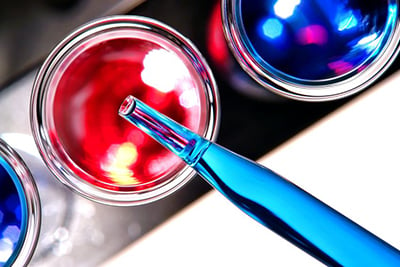 Skincare has been one of the most innovative areas in personal care during the last 50 years. Below I’ve highlighted technical insights and materials that I believe have been important to the growth and development of breakthrough products.
Skincare has been one of the most innovative areas in personal care during the last 50 years. Below I’ve highlighted technical insights and materials that I believe have been important to the growth and development of breakthrough products.
Excipients
Xanthan Gum
Xanthan gum is the most important commercially available polysaccharide and probably the most commonly used in personal formulations. It is a work horse ingredient. Xanthan gum was discovered in the 1950s by scientists of the Northern Regional Research Laboratory of the U.S. Department of Agriculture in the course of a screening aimed at identifying microorganisms that produced water-soluble gums of commercial interest. It was commercialized by CP Kelco under the trade name KELTROL®/KELZAN® in 1964 and approved for food use in 1968
Carbopol®
Carbopol® (Carbomer) was the original synthetic powdered, alkali swellable thickening polymer and was commercialized in 1958 by BF Goodrich (now known as Lubrizol). Carbopol® 940, 941, and 934 were breakthrough technologies that revolutionized how personal care products were formulated. It created new types of products that were previously not possible such as clear gels and stable oil in water emulsions with excellent consumer appeal.
Hydrophobically Modified Polymers
Carbopol® 1342 was the first hydrophobically modified polymer developed for personal care use by B.F. Goodrich (now Lubrizol). It enabled the development of sterically stabilized emulsifier free oil in water emulsions and were more salt tolerant than carbomers.
Silicone Cross-Linked Gels
Silicone cross-linked gels dispersed in silicone carriers for personal care use were developed by Shin-Etsu in 1988 and the first emulsifying gels in 1991. Since being introduced, they have had a major impact on color cosmetic, antiperspirant, and skin care formulations due to their outstanding skin feel properties. Also they have revolutionized the formulation of water in oil emulsions due to their excellent stability, skin feel, and ability to emulsify up to 90% water
Fundamental Understanding of Lamellar Gel Networks
The published work by Eccelston, Junginger, Fukushima, and numerous others provided a fundamental understanding how LGNs structure water and stabilize oil in water emulsions. LGN technology is the basis of most hair conditioners and oil in water emulsions sold globally.
Vesicular Delivery Systems
All vesicular systems are comprised of single or multilamellar layers of surfactants surrounding spherical bodies. The surfactants can be anionic, cationic, or nonionic. The original vesicular systems were called liposomes and were phospholipid based. They were first described by Bangham in 1961. Various types of vesicular systems have been extensively used in skincare products to promote active skin penetration, active stability, and improve moisturization.
Active ingredients
Avobenzone
Avobenzone (Butyl Methoxydibenzoylmethane) is the most important UVA absorber used and approved globally. Avobenzone was patented in 1973 and commercialized by Hoffman LaRoche as Parsol 1789. It was the first long wave UVA absorber introduced. It was approved as a monographed sunscreen in the EU (up to 5%) in 1978 and by the FDA (up to 3%) in 1996. Avobenzone helped to create the first daily wear SPF products positioned to prevent UV A induced premature skin damage.
Niacinamide
Niacinamide is one of the most useful multifunctional materials currently used in skin care products. It has been shown to have skin lightening, oil control, pore reducing, barrier repair/epidermal lipid stimulating, moisturizing, and anti-inflammatory activity.
Alpha Hydroxy Acids
AHAs helped create the modern anti-aging skin care category. Van Scott and Yu were the first to recognize the skin care benefits of AHAs and highlighted the restorative benefits of alpha hydroxy acids, specifically glycolic acid in peer reviewed journals. Further research indicated that AHAs also worked in wrinkle reduction, skin renewal, and helped reverse of some effects of skin aging.
Peptides
Peptides were first commercialized by Sederma for personal care in the late 1980s. Peptide technology helped revolutionize current anti-aging formulations and represented the second generation of skin repair actives following alpha hydroxy acids. Peptides are effective at concentration as low as 3-10 ppm.
Matrix Metalloproteinases (MMPs) Inhibitors
MMPs are a group of 23 different enzymes that cause proteins in the body to break down. When you’re young the rate of synthesis of new tissue and replacement are in balance. On aging this shifts to degradation due to increased MMP activity. Increased levels of MMPs due to environmental exposure is now accepted as one of the leading causes of premature skin aging. Numerous MMP inhibitors have been commercialized and are currently used in antiaging products.
The Development of TRVP Inhibitors to Treat Skin Sensitivity
The function of TRPV1 is the detection and regulation of body temperature. In addition, TRPV1 receptors provide sensation of heat and pain. SymSitive 1609 (Pentylene Glycol and 4-t-Butylcyclohexanol-Symrise) was one of the first TRVP inhibitors specifically developed to treat sensitive skin.
View all products on Prospector…
The views, opinions and technical analyses presented here are those of the author or advertiser, and are not necessarily those of ULProspector.com or UL Solutions. The appearance of this content in the UL Prospector Knowledge Center does not constitute an endorsement by UL Solutions or its affiliates.
All content is subject to copyright and may not be reproduced without prior authorization from UL Solutions or the content author.
The content has been made available for informational and educational purposes only. While the editors of this site may verify the accuracy of its content from time to time, we assume no responsibility for errors made by the author, editorial staff or any other contributor.
UL Solutions does not make any representations or warranties with respect to the accuracy, applicability, fitness or completeness of the content. UL Solutions does not warrant the performance, effectiveness or applicability of sites listed or linked to in any content.


